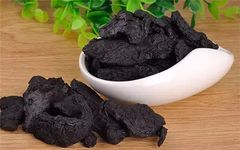Shudi (熟地), a type of Dihuang (地黄), is categorized into Shengdi (生地) and Shudi. What are the effects of Shudi? Today, we will discuss the four major effects of Shudi. Are you familiar with them?
The Effects of Shudi
Research comparing the effects of Shudi and Shengdi on vascular thrombosis syndromes indicates that the coarse Shudi produced in China can significantly inhibit hepatic hemorrhagic necrosis and simple necrosis.
Shudi has a relatively weak anticoagulant effect. Using the fibrin plate method to explore its activation effect on the fibrinolytic system, it was found that Shudi has an activating effect, while Shengdi does not.
There are also reports suggesting that both Shudi and Shengdi have hemostatic effects before and after being charred, and that the hemostatic effect of charred Shudi is not enhanced.
Analysis of the hemostatic effects of the decoctions of Shengdi, Shudi, Shengdi char, and Shudi char showed no significant differences.
1. The Anti-Aging Effect of Shudi
Shudi decoction at 20% concentration was administered via gavage at 0.3ml daily for 45 days. Blood samples were taken for the measurement of superoxide dismutase (SOD), catalase (CAT), glutathione peroxidase (GSH-Px) activity, and lipid peroxidation (LPO) levels.
The results showed that Shudi can enhance GSH-Px activity and reduce serum LPO levels, with P values of <0.05 and <0.01 compared to the control group.
2. Effects on Hyperthyroid Yin Deficiency Rats
Triiodothyronine (T3) was administered to rats to create a Yin deficiency model, followed by administration of Shudi decoction at 3ml (70% concentration) for 6 days, after which various data were measured.
There were no significant differences in signs, weight changes, 24-hour water intake, urine output, or plasma concentrations of hormones such as T3, thyroxine (T4), and aldosterone (AD) between the treatment and control groups (P>0.05).
However, after modeling, the Yin deficiency group showed significant changes compared to the normal group, such as increased excitability and aggression, weight loss, increased 24-hour water intake, and elevated T3 levels, with decreased T4 and AD levels.
After treatment with Shudi, the aforementioned symptoms and indicators significantly improved, approaching normal levels (compared to the Yin deficiency group).
For instance, the plasma AD concentration in the Shudi group was significantly elevated (P<0.05), and the 24-hour urine output significantly decreased (P<0.01), indicating that Shudi has a nourishing effect on Kidney Yin and is related to the improvement of AD levels in the body.
The plasma concentrations of T3 and T4 in the Yin deficiency treatment group showed significant improvement (T3 decreased, T4 increased), approaching normal levels.
This indicates that Shudi can not only improve Yin deficiency symptoms through systemic regulation but also has a regulatory effect on abnormal thyroid hormone levels.
Furthermore, compared to the normal group, the treatment group still showed significant differences in weight changes, 24-hour water intake, and plasma T3 and T4 concentrations, indicating that while there were significant improvements compared to the Yin deficiency group, full recovery to normal levels was not achieved. This suggests that the effects of Shudi have limitations.
3. Experimental Observation of the Blood-Enriching Effect of Shudi
Shengdi and Shudi were prepared into a 1:1 decoction and administered to mice to observe their effects on hemorrhagic anemia, hematopoietic stem cells, and bone marrow erythroid progenitor cells (CFU-E).
The results showed that Shengdi and Shudi had significant effects on hemorrhagic mice, with the Shudi group recovering faster after 8 days of treatment, with RBC and Hb counts showing P values of 0.001 and 0.01 compared to the control group.
Shengdi and Shudi also exhibited certain proliferative and differentiative effects on hematopoietic stem cells, suggesting that the blood-enriching effect of Dihuang is related to the promotion of blood cell production by hematopoietic stem cells.
Analysis of the generation of erythroid cells in the bone marrow of mice showed that the number of erythroid colonies in the saline group was 52.4±18.41, while in the Shengdi and Shudi groups, it was 60.2±19.44 and 125±20.45 respectively (P<0.05). This suggests that the blood-enriching effect of Dihuang is closely related to the bone marrow hematopoietic system.
4. The Effect of Charred Dihuang on Hemostasis
Shengdi, Shengdi char, Shudi, and Shudi char were prepared into decoctions containing 100g of raw herb or 33g of charred herb per 100ml.
Each sample was administered to mice at a dose of 0.8ml/20g, and blood was collected from the left eye’s inner canthus and the retro-orbital venous plexus to measure coagulation time, comparing it with the saline group.
The results showed no significant differences (P>0.05), suggesting that Dihuang does not require processing for hemostatic effects.

